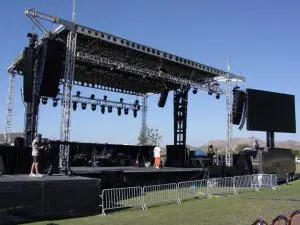
Wind Loads on Temporary Structures
In the course of one of our recent web seminars, we were asked about design wind loads on temporary structures. Due to their short design life compared to regular structures, it is expected that the temporary structures would be less likely to be subjected to the design wind speeds specified in ASCE 7. However, scant information is readily available on how much reduction in the design wind speed would be reasonable for temporary structures. This blog attempts to assemble some information relevant to this topic.
According to Gorlin (Journal of Architectural Engineering, ASCE, June 2009, pp.35-36), “Temporary structures encompass a wide range of items such as concert and theatrical stages, tents, public art projects, temporary roofs and shade structures, lighting and speaker towers, temporary grandstands and bleachers, and many other facilities.” However, there is no nationally recognized standard specifying design wind loads for such structures.
The 2015 IBC addresses temporary structures only superficially in its Section 3103. This section applies to structures erected for a period of less than 180 days, excluding tents and other membrane structures. However, nothing is mentioned on how to determine the design loads on such a structure except for a generic statement that “Temporary structures and uses shall conform to the structural strength, fire safety, means of egress, accessibility, light, ventilation and sanitary requirements of this code as necessary to ensure public health, safety and general welfare.”
In the absence of any clear requirements or guidelines, engineers often look to another standard: ASCE 37, Design Loads on Structures during Construction. ASCE 37 incorporates provisions for adjusting wind loads to reduce them for short-term exposure during construction for up to five years. This document provides the following reduction factors for the design wind speeds given in ASCE 7 based on the duration of construction.
| Construction Period | Factor |
| Less than six weeks | 0.75 |
| From six weeks to one year | 0.8 |
| From one to two years | 0.85 |
| From two to five years | 0.9 |
So, based on ASCE 37, the wind load applied to a structure under construction for less than six weeks is 56% ( = 0.75 x 0.75) of that applied to a permanent structure, due to its reduced probability for being exposed to the same design wind event as a permanent structure.
Another document that addresses temporary structures is one of the Unified Facilities Criteria (UFC) documents issued by the U.S. Department of Defense – UFC 1-201-01 dated 1 January 2013, Non-Permanent DoD Facilities In Support Of Military Operations. In this UFC, Non-permanent facilities are broken down into three construction levels: Initial, Temporary, and Semi-permanent. The levels of construction are based on life expectancy of the facility.
Initial facilities are set up on an expedient basis with minimal external engineering design support. For construction, service, host nation, or contracted equipment and systems are used. Common facility types include tents, containers, and fabric shelters.
Temporary buildings and facilities are designed and constructed to serve a life expectancy of five years or less using low-cost construction.
Semi-Permanent buildings and facilities are designed and constructed to serve a life expectancy of less than 10 years. With maintenance and upkeep of critical building systems, life expectancy of facility can be extended to 25 years.
According to this UFC, it is permissible to multiply the basic wind speed, V, as applicable to a permanent structure, by a reduction factor of 0.78 for structures that meet the definition of temporary construction except in regions defined as Hurricane Prone Regions.
The entertainment industry also has a standard for temporary concert stage roofs that considers the limited duration of exposure and human factors. The standard, developed by ANSI and Entertainment Services and Technology Association (ESTA) is ANSI E1.21, titled: Temporary Ground-Supported Overhead Structures Used to Cover the Stage Areas and Support Equipment in the Production of Outdoor Entertainment Events. This ANSI document specifies the design wind speed to be 0.75 times the basic wind speed defined in ASCE 7.
According to Gorlin, “People use forecasting and good judgment in everyday circumstances to deploy temporary structures—village placards, farmers’ market tents, shade structures, umbrellas—in wind speeds much lower than codes stipulate. In almost all these scenarios, the structures are dismantled in time.
Engineers attempt to apply this common sense approach to more significant engineered structures. We must use our judgment to arrive at a wind-speed threshold above which action is required to eliminate risk. We must also establish the appropriate level of manpower, equipment, and time to dismantle the assembly safely and in a timely manner.”